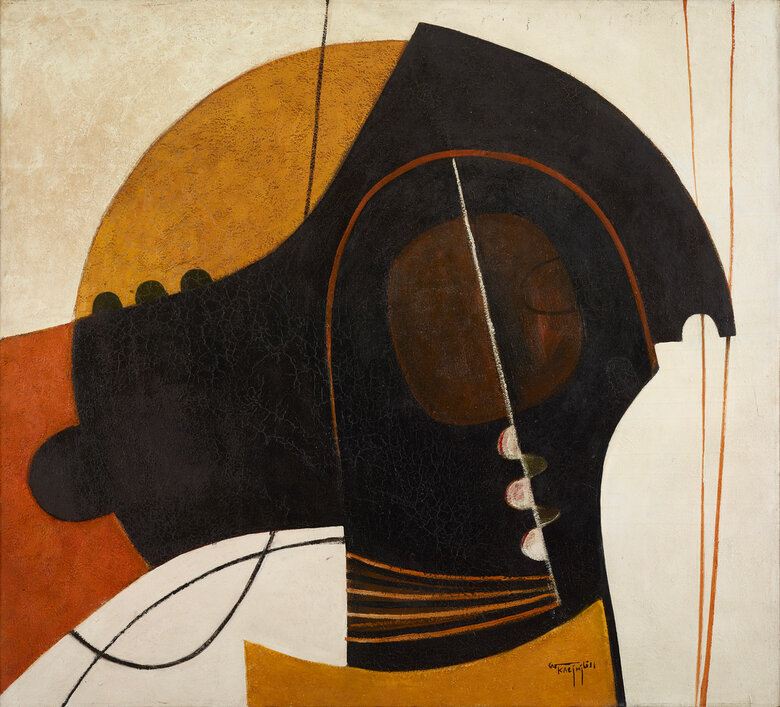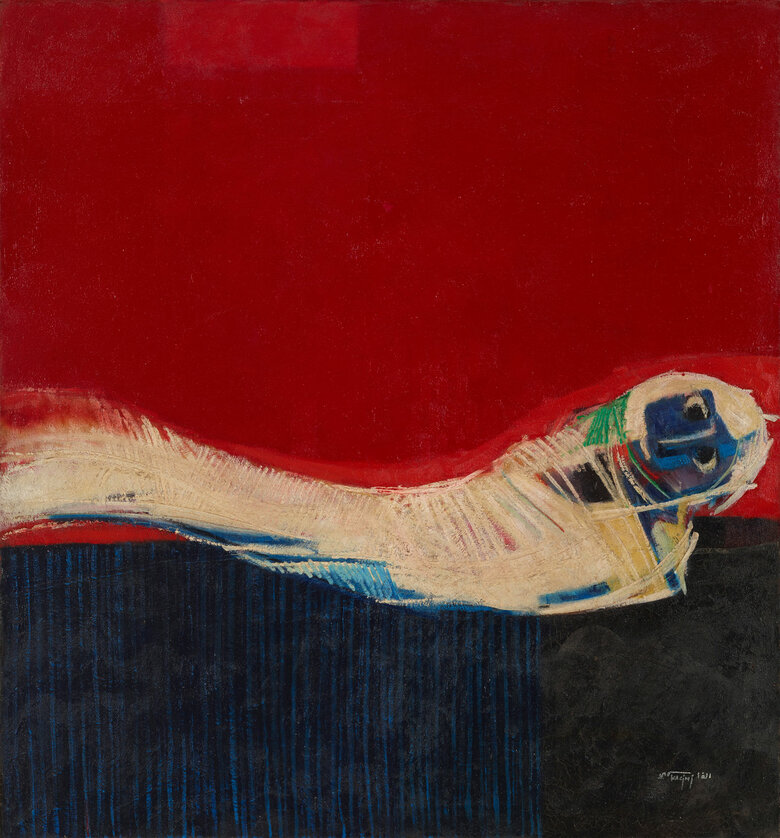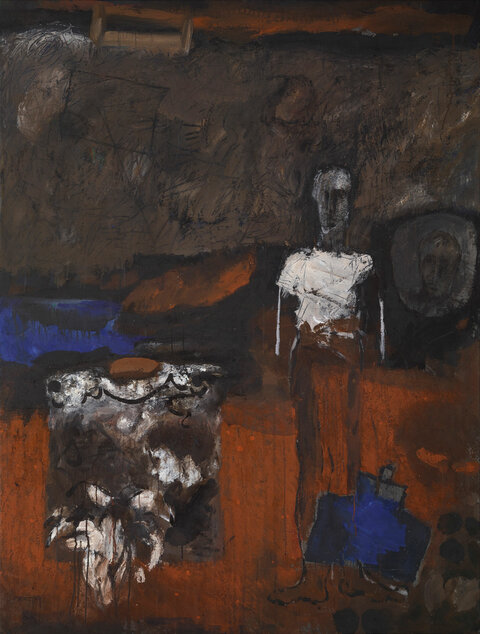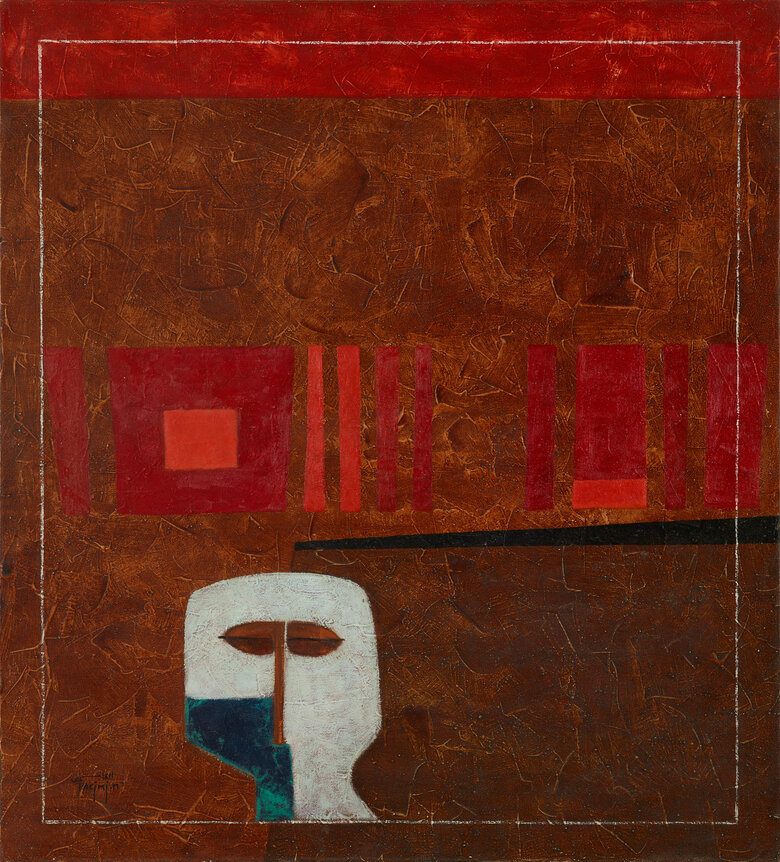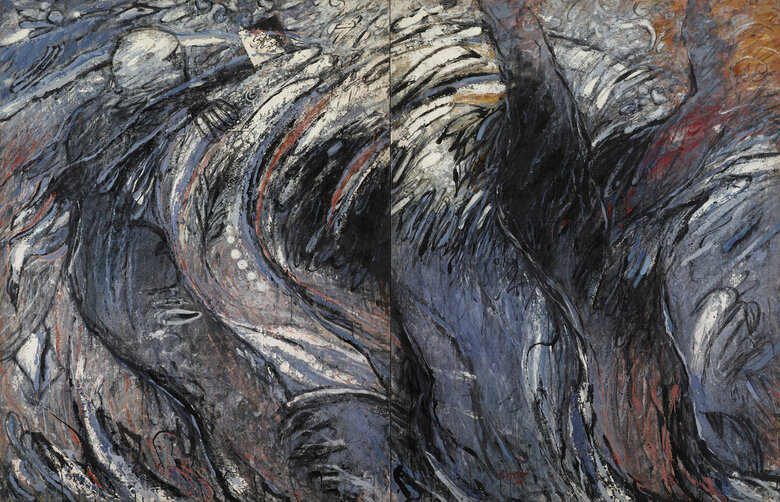Written by Wafa Roz Born in 1942 in Meknes, Morocco, Mohamed Kacimi was a painter and writer whose nomadic lifestyle led him to find poetic wonder in new places, experiences, people and...

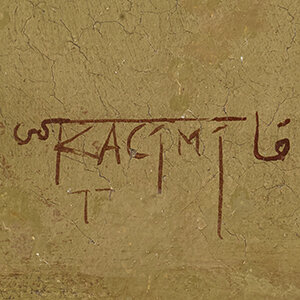
MOHAMMED KACIMI, Morocco (1942 - 2003)
Bio
Written by Wafa Roz
Born in 1942 in Meknes, Morocco, Mohamed Kacimi was a painter and writer whose nomadic lifestyle led him to find poetic wonder in new places, experiences, people and environments. He was an avid reader and an avant-garde thinker with an early interest in visual and performance art. Having studied Arabic literature at the University of Fes, where he enrolled in 1960, Kacimi was essentially a self-taught painter; he only briefly studied painting in 1963, when he was granted a year-long scholarship to Paris’s ABC School of Art. In 1972, Kacimi began writing for various journals and newspapers in Morocco and the Arab world and became the founding member of the journal Alischara (Signs) as well as a member of the Association Marocaine des Arts Plastiques.
Kacimi’s artistic career was sparked by a revelation in 1959, when the young artist first laid eyes on the works of Jilali Gharbaoui in Meknes. He was captivated by Gharbaoui’s audacious approach and highly gestural technique. Four years later, Gharbaoui would become his close friend and mentor, encouraging Kacimi to explore the world. From 1964 to 1968, the artist toured Europe, discovering the drama of the Spanish golden age, the classical revival of the Italian quattrocento, and the vibrant realism of early modern Flemish art. He visited the Louvre in Paris, returning over and over again to explore the work of the Old Masters and the department of Egyptian art, which fascinated him the most. During this time, he also familiarized himself with the work of renowned Western artists of the 20th century, including Nicolas de Staël, Afro Basaldella, Hans Hartung, and Georges Rouault, which played a key role in the development of his style. Though he learned much from his time in Europe, he did not lose touch with the Arab art world, maintaining close contact with several influential artists such as Jewad Selim, Ismael Fattah, Ahmad Cherkaoui and Dia Al-Azzawi.
Kacimi’s unique artistic style is most celebrated for its mystical elements, with his canvases featuring haunting, often indistinct figures set against abstract backgrounds of varying contrasts. In his early stages, from the mid-1960s to the late 1970s, he adopted abstractions of different leanings, beginning with a loose, vibrant, lyrical style and later investing in earth-toned compositions of strong lines and bold geometrical shapes. Nearing the 1980s, his style shifted drastically. He abandoned oil paint almost entirely, taking up acrylic-based paints and creating the blue pigment that would become iconic of his work. In 1979, the artist moved to the coastal town of Harhoura-Temara with his wife, Noëlle Piron, and their daughter Batoul. Inspired by the waves of the Atlantic against the Moroccan shore, Kacimi discovered new windows into the world, creating a series of paintings entitled “Les Océanides” that featured graphical reverberations of footsteps traveling away from the vista of his painting to an unknown destination. He integrated fingerprints, visa stamps and texts within a gridded composition and an earthy palette, depicting the difficulty of migration. His paintings developed into wild, bright calligraphic forms that splashed on loose hanging canvases.
Following a voyage into the deserts of Morocco and the Atlas Mountains, the 1990s were the artist’s most creative and prolific years. During this time, he created “Les Atlassides,” a haunting series inspired by the ancient civilization of the Amazigh (Berbers). Drawing on cave art, this work evidences primitivism and spontaneity whilst maintaining confidence and mastery of composition. In densely textured gestural strokes, Kacimi introduced eerie ghostlike bodies that wander his canvas as if in search of a getaway. Another body of work entitled “Le Temps des Conteurs” tells the stories of his travels in sub-Saharan Africa, marking Kacimi’s signature style. Characterized by an economy of line and simplicity of form, this work features shapeless bodies floating in an open space with symbolic figures, texts, and codes, its color scheme dominant in ochre, burnt orange, black and blue. The almost paradoxical relationship between his dark tonalities and his soft lines ultimately imbues the work with its originality. During this period, Kacimi experimented with different materials, introducing paper, bitumen, chicken wire, and plaster into his canvas. His art portrayed an existential struggle and reflected on his relationship to the figure of ‘’the demiurge’’- the creator. A cosmic feel governed his last works, almost giving the sense that the artist anticipated an interplanetary journey between the spiritual and the material.
Kacimi would have painted the world if he could. In 1992, he presented a project at the 4th Cairo Biennale entitled Éloge de I ‘imagination-La Pyramide bleu that proposed projecting color onto the Pyramids of Giza via laser light, essentially ‘painting’ the pyramids blue. This was deemed unacceptable, with detractors protesting that it would disturb the soul of the Pharaoh Khufu (Cheops); no one, it was argued, messes with the holy wonders of the ancient world. Kacimi responded sarcastically in Egyptian Arabic, “Koullo illa el haram ya Kacimi” – “Anything but the blasphemous, Kacimi.”
Towards the end of his life, Kacimi engaged in public art projects, urban installations, and performances, expressing a commitment to making art accessible to ordinary people. For instance; he painted abstract murals on the houses of Assila during the annual art Moussem (festival) in Morocco, and portraits on huge baskets fixed on the shore of Ouida in Benin. Similarly, in 1996, at the Maison de la Culture in Bourges, France, Kacimi executed three iconic large-scale (11x2.5m) paintings in situ depicting the barbarism of the Gulf War, entitled “L’Oracle des temps.” This installation was complimented by the performance of a dancer. Kacimi was also committed to humanitarianism and social work; in 1997, along with his friend psychoanalyst Jalil Bennani and his second wife, psychiatrist Chafika Sekkat, he undertook a project that used art as a form of therapy to help psychologically disturbed teens.
Having started as a teenage amateur from Meknes, tortured by the colonial French police, Kacimi arrived at the UNESCO Headquarters in Paris in 1998 as a renowned artist and a founding member of the Moroccan Organization of Human Rights (OMDH). It is fair to say that the artist’s journey was a remarkable one; sadly, it ended in 2003, when Kacimi passed away in Rabat due to Hepatitis-C related complications. The artist’s legacy lives on, however, and he is considered one of Morocco’s most inspiring contemporary artists to this day.
Sources
Descendre, Nadine. Mohammed Kacimi catalogue raisonné. Vol. 1. 2 vols. Rabat, Morocco : Art'Dif éditions, 2017.
Descendre, Nadine. Mohammed Kacimi catalogue raisonné. Vol. 2. 2 vols. Rabat, Morocco : Art'Dif éditions, 2017.
ALIPLAGE1. "L'ARTISTE MOHAMED KACIMI." YouTube. April 25, 2008. Accessed April 11, 2018. https://www.youtube.com/watch?v=ZTssRvBZgH8
Badre Belhachemi. “Mohamed kacimi (Namadij 2M).” YouTube. November 23, 2012. Accessed April 11, 2018. https://www.youtube.com/watch?v=9hj4vvvrtJk
Kacimi Mohammed, Parole Nomade, Al Manar. Accessed April 11, 2018. https://www.editmanar.com/peintres/Kacfr.htm.
Le360Live. "Le360.ma • "Résistance" : Une Exposition Hommage à Mohamed Kacimi. YouTube. October 20, 2016. Accessed April 11, 2018. https://www.youtube.com/watch?v=NZrSRomYJ0g
Matin, Le. "L'africanité De L'œuvre Mohamed Kacimi Dévoilée à Casablanca." Le Matin. Accessed April 11, 2018. https://lematin.ma/journal/2014/arts-plastiques_l-africanite-de-l-oeuvre-mohamed-kacimi-devoilee-a-casablanca/209219.html.
"الجزيرة نت - طباعة الخبر". Accessed April 11, 2018. http://www.aljazeera.net/home/print/f6451603-4dff-4ca1-9c10-122741d17432/dbf99973-c421-4c7e-a0ee-74127a402002.
CV
Selected Solo Exhibitions
2019
Kacimi 1993-2003, an African transition, MUCEM, Marseille, France
2016
Hommage à Mohammed Kacimi, Journées du livre africains, Montréal, Canada
2013
L’art comme geste extrême, Al-Maghrib Bank Museum of Art, Rabat, Morocco
2009
Kacimi, un hommage, Espace Expression CDG, Rabat, Morocco
2005
Mohammed Kacimi Gallery at Fes - Opening, Fes, Morocco
2003
Mohamed Kacimi, Al Riwaq Art Gallery, Bahrein
2002
Florence Touber Gallery, Paris, France
Atelier Porte 2 A, Bordeaux, France
French Institute, Dakar, Senegal
1998
Le Bateau-Lavoir Gallery, Grenoble, France
1996
Maison de la culture, Bourges, France
1995
Galerie Bab Rouah, Rabat, Morocco
1994
Atelier ouvert, Hôpital Ephémère, Paris, France
1993
Centre International des Etudiants et Stagiaires, Paris, France
1991
Bab-el Kebir -Oudayas, Chehrazad et La Guerre, Morocco
1990
Huit Gallery, Poissy, France
Nadar Gallery, Casablanca, Morocco
Arcanes Gallery, Ouray’s, Rabat, Morocco
1988
Arab World Institute, Paris, France
1987
Gallery Alif-Ba, Casablanca, Morocco
1985
Bonlieu Center, Annecy, France
Jean-Claude David Gallery, Grenoble, France
1984
F.O.L. Gallery, Montpellier, France
1982
Nadar Gallery, Casablanca, Morocco
Office of Tourism Gallery, Marrakech, Morocco
1981
Central Gallery, Geneva, Switzerland
1977
Nadar Gallery, Casablanca, Morocco
1975
Nadar Gallery, Casablanca, Morocco
Galerie d’Art Moderne, Casablanca, Morocco
1972
Galerie du Conservatoire municipal de Meknès, Morocco
1968
Galerie La Découverte, Rabat, Morocco
1964
First Solo Exhibition at : Conservatoire municipal de Meknès, 45 works shown, Morocco
Selected Group Exhibitions
2024
60th Venice Biennale - Stranieri Ovunque / Foreigners Everywhere, La Biennale di Venezia, Venice, Italy
2023
Casablanca Art School, Tate St. Ives, St. Ives, Cornwall, United Kingdom
Parallel Histories, Sharjah Art Museum, Sharjah, United Arab Emirates
2022
Our Land Just Like a Dream, Musée d'Art Contemporain Africain Al Maaden, MACAAL, Marrakech, Morocco
2018
A Century in Flux, Highlights from the Barjeel Art Foundation, Sharjah Art Museum,
Sharjah, UAE
Miroir collectif, central Bank Museum, Rabat, Morocco
Truth is black, write over it with a mirage’s light, Darat Al Funun, Amman, Jordan
2016
The Short Century, Barjeel Art Foundation, Sharjah Museum, Sharjah, UAE
2015
Une collection, quatre regards, Espace d’art de la Société Générale Maroc, Casablanca, Morocco
Rituals of Signs and Transitions (1975-1995), Darat Al Funun, Amman, Jordan
2014
40 ans de regard sur l’art au Maroc, Nadar Gallery, Casablanca, Morocco
2013
Exposition collective d’artistes marocains, L’Atelier, Rabat, Morocco
Tajreed, CAP Kuwait, Kuwait
2012
100 ans de peinture au Maroc, International Fair for Books and Press, Geneva, Switzerland
2011
A Brave New World, National Museum of African Art, Smithsonian Institution, Washington, D.C., USA
2010
Couleurs, Passions, Rencontres et Histoire, Nadar Gallery, Casablanca, Morocco
2008
Traces et Paroles, National Library of Morocco
2007
Art Inspired by poetry, Darat Al Funun, Amman, Jordan
2006
Dakar Biennale, Senegal
2004
Art contemporain du Maroc, French Parliament, Brussels, Belgium
2003
Brunei Gallery, SOAS University, London, UK
2002
Galerie Le Bateau Lavoir, Grenoble, France
2001
Maroc contemporain : Peintures et Livres d’artiste, De Markten, Brussels, Belgium
Palais de l’Unesco, Beirut, Lebanon
Galerie Florence Touber, Paris, France
1998
Musée d’Art Moderne, Paris, France
1997
Couvent des Cordeliers, Paris, France
1996
Biennale international of Dakar, Senegal
1995
La peinture marocaine dans les collections françaises, BMCE, Paris, France
1993
5th international Biennale of Cairo, Egypt
1992
Galerie Ipso, Saint-Gilles, Belgium (along with Farid Belkahia and Fouad Bellamine)
1990
1st Biennale of Dakar, Senegal
1989
Etienne Dinet Gallery, Paris, France
Foire Internationale de Flandre, Gand, Belgium -Ethnic, Modern, Contemporary Art
1988
Provincial Museum, Liège, Belgium
1987
Arab Contemporary Art, London, UK
International Exhibition, Baghdad, Iraq
19th International Biennale at Sao Paulo, Brasil (along with Farid Belkahia, Fouad Bellamine, Mohamed Melihi and Bdelkebir Rabi)
1985
Palais de la Porte Dorée, Paris, France
1983
Moroccan Painting, Kuwait
Walt Disney Hall, Los Angeles, California, USA
2nd
Biennale of Tunis, Tunisia
1980
1st
Biennale of Tunis, Tunisia
“Art Arabe Contemporain”, Museum of Modern Art, Tunis, Tunisia
Graphic Art Biennale of Baghdad, Iraq
1979
6th Arab Exhibition, Kuwait
1978
International Exhibition of fine arts for Palestine, Beirut, Lebanon
1974
First Biennale de Baghdad (Biennale Panarabe), Baghdad, Iraq
First Exposition Maghrébine in Algiers, Algeria
1972
Galerie La Découverte, Rabat, Morocco Group Exhibition organized by FATH
1971
L’Atelier, Rabat, Morocco
Awards and Honors
1998
7th Biennale of Cairo, Egypt, First Prize
1995
5th Biennale of Cairo, Egypt, First Prize
1994
4th Biennale of Pastel, St. Quentin, France, first prize
1993
4th Biennale of Cairo, Egypt, Prize of Honor
Social & Public Participations
1998
Exhibition and contribution to publishing Liberté 98 book, during the 50th anniversary of the Universal Declaration of Human Rights, UNESCO, Paris, France
1997
Installation at the Medersa Ben Youssef, Marrakech, Morocco
1996
Public Painting, Maison de la Culture de : Bourges, Amines et Nerves, France
1995
Hôpital Éphémère - installation, 1st 6 large scale paintings of Le Temps des conteurs, France
1994
La Route de L’esclave, Benin, Africa - huge baskets painted and fixed at the shore.
Hôpital des Enfants, Rabat, Morocco - large scale painting executed for children
Hôpital Éphémère Project - artist residence at the Hôpital Bretonneau, France
1993
Oriflammes De Limoges, France - urban installation of 50 painted banners.
Grotte Des Temps Futurs, Installation at the Centre culturel Français, Rabat, Morocco
1992
Mural painting, Musée d’Art Contemporain d’Anvers, Belgium
Performance with dancer Catherine Pouzet, Kash Theater, Antalya, Turkey
1988
7 Haiks, tinted in Marrakesh, some hanged at Bab El Kibir, Morocco
1987
Second Mural, Assila, Morocco
1985
Public Installation on the beach, 7 painted flags, Harhoura, Temara, Morocco
Public painting with the participation of singer Diad and writer Abdellatif Laabi , Grenoble, France
Mural painting, Grenoble, France
1984
An abstract painting study for the Ministry of Engineering, Morocco
1977
First intervention with children ; La Parole aux enfants, Place Piétri, Rabat, Morocco
First mural, Assila, Morocco
Publications
2015
Tahar Ben Jelloun, Mohammed Kacimi, Lettre à Matisse
2008
Mohammed Kacimi and Jalil Bennani, Traces et paroles, Des adolescents, un peintre, un psychanalyste
2004
Abdellatif Laâbi and Mohammed Kacimi, Ruses de vivant
2003
Mohammed Kacimi, Festival d’Essaouira/Vécu comme un livre ouvert Collectif, Hommage à Kacimi
2001
Mohammed Kacimi, L’éspace mental et l’école
1999
Mohammed Kacimi, Parole nomade, l’expérience d’un peintre
1997
Mohammed Kacimi, Le Bus de la connaissance
1994
Mohammed Kacimi, Le Corps de la mémoire
1991
Mohammed Kacimi, Imaginaire et réalité
1987
Mohammed Kacimi, Autour des Intensités
1981
Mohammed Kacimi, Lettre ouverte d’un peintre marocain à un douanier suisse
1979
Mohammed Kacimi, La peinture marocaine/Situation
Collections
National Museum of African Art, Smithsonian, Washington D.C., USA
Ramzi and Saeda Dalloul Art Foundation, Beirut, Lebanon
Khalid Shuman Foundation: Darat Al Funun,Amman, Jordan
Barjeel Art Foundation, Sharjah, UAE
Kinda Foundation Contemporary Art Collection, Saudi Arabia
Press
وفاة الفنان التشكيلي المغربي الرائد محمد القاسمي.pdf
Hommage à Mohammed Kacimi _ Le geste extrême d’un artiste total - La Nouvelle Tribune.pdf
الجزيرة.نت.pdf
وفاة الفنان التشكيلي المغربي الرائد محمد القاسمي,.pdf
منتديات ستار تايمز.pdf
فضاء يحتضن تراث الفنان المغربي في ذكرى رحيله . محمد القاسمي ... باق في الهرهورة .pdf
elaph.pdf
Aujourd_hui.ma.pdf
CE SOIR_ MOHAMMED KACIMI, L_AFRICAIN À LA CMOOA.pdf
Al Adabia.pdf
Al Arab.pdf
Le Matin - L’africanité de l’œuvre Mohamed Kacimi dévoilée à Casablanca.pdf
L_economiste.com.pdf
depliant_de_lexposition_version_ar.pdf
دراسات محمد القاسمي.pdf
التشكيلي محمد القاسمي أو الفن كحركة قصوى _ أخبار ثقافة _ الجزيرة نت.pdf
تقديم فهرس أعمال الرسام المغربي محمد القاسمي في الرباط.pdf
LeSiteinfo.pdf
Lavieeco.pdf
آربريس _ الفنان التشكيلي محمد القاسمي بعيون المؤرخة نادين ديسندر-أخبار.pdf
استعادة الرسام المغربي الراحل محمد القاسمي بأعمال فريدة _ اندبندنت عربية.pdf
Le top 8 des oeuvres marocaines les plus chères _ Telquel.ma.pdf
MOHAMMED KACIMI Artwork
Become a Member
Join us in our endless discovery of modern and contemporary Arab art
Become a Member
Get updates from DAF
Follow Artists
Save your favourite Artworks
Share your perspectives on Artworks
Be part of our community
It's Free!
We value your privacy
TermsCookiesPrivacy Policies
Become a Member
Get updates from DAF
Follow Artists
Save your favourite Artworks
Share your perspectives on Artworks
Be part of our community
It's Free!
We value your privacy
TermsCookiesPrivacy Policies
Become a Member
Get updates from DAF
Follow Artists
Save your favourite Artworks
Share your perspectives on Artworks
Be part of our community
It's Free!
We value your privacy
TermsCookiesPrivacy Policies
Welcome to the Dalloul Art Foundation
Thank you for joining our community
If you have entered your email to become a member of the Dalloul Art Foundation, please click the button below to confirm your email and agree to our Terms, Cookie & Privacy policies.
We value your privacy, see how
Become a Member
Get updates from DAF
Follow Artists
Save your favourite Artworks
Share your perspectives on Artworks
Be part of our community
It's Free!
We value your privacy
TermsCookiesPrivacy Policies

-Front.jpg)
-Front.jpg)
